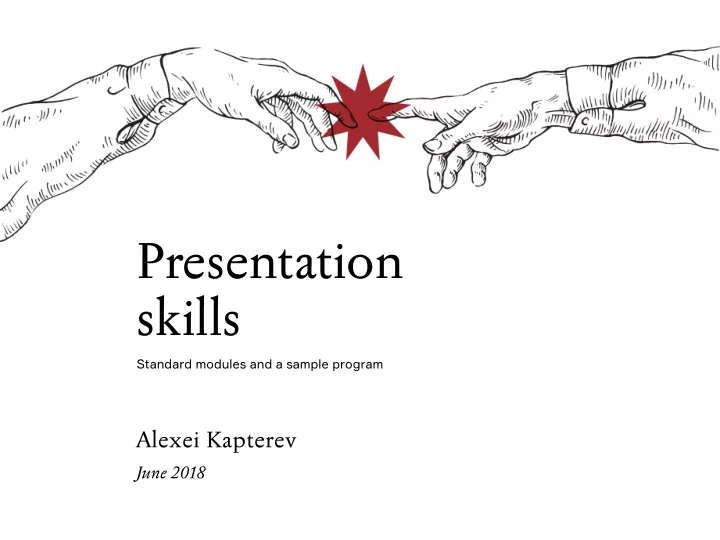

Presentation skills Standard modules and a sample program Alexei Kapterev June 2018
1. Wi y structure matters People complain that presentations are either boring and confusing or entertaining but meaningless. How can we address this problem at the level of structure? 2. Four presentation genres What do we mean when we say “presentation”? Do we mean Module 1 something that is designed primarily to inform (lecturing), entertain (comedy), persuade (sales) — or make the audience STRUCTURE think for themselves (Socratic dialogue)? How do we integrate those conflicting goals? What body language would better support what goal? Key objective 3. Ti e anatomy of presentation Learn to create a logical, coherent and motivating Four key parts of a presentation: 1) Establishing contact script for a presentation. 2) Motivation 3) Exposition 4) Closing. Questions we should answer to get a working structure. We should start from a Audience problem but not all problem formulations are the same. People with some or no 4. Case studies experience in creating presentations. Structure: an unlikely secret to charisma. Things we can borrow from Steve Jobs, Jeff Bezos and McKinsey consultants in terms of structure. www.kapterev.com � 2
1. Design fundamentals Design goals and priorities: aesthetics, usability and cost considerations. Why good design always begins with empathy. Fighting information overload with design. 2. Typography Using font sizes, styles, indents and principles of good composition to solve the problem of “too much text”. Creating Module 2 visual hierarchy to communicate priorities. Fundamentals of typographic illustration. DESIGN 3. Pictograms and photographs Using pictograms, drawings and photographs to illustrate key Key objective concepts. What is a “good illustration”? Combining illustrations with text. Learn to create legible, easy to understand and aesthetically pleasing slides which help the presentation 4. Diagrams rather than obstruct one. Creating hierarchical, process and relational diagrams. Solving the problem of “how many blue boxes you can have on one slide Audience before it’s too much?” People with basic knowledge of Microsoft PowerPoint or Apple Keynote. 5. Data visualisation Working with bar/column charts, line charts, pie charts. Why good chart design begins with a good header. Creating focal points. Removing “chart junk”. www.kapterev.com � 3
1. Wi at’s a “good presentation”? How do we judge a presentation? How do we make the feedback useful? Discussing the evaluation criteria. 2. Presentations Participants should come to the seminar with a draft 7-12 minute presentation, preferably with slides. About 1.5 hours will be reserved for any additional preparation that might be Module 3 needed. FEEDBACK 3. Feedback SESSION Trainer-moderated feedback session. What really worked, what can we “steal” from the speaker? What didn’t work and how can we correct that? How can we make the feedback helpful rather than humiliating? Key objectives Practice presenting, learn to give and 4. Analysis accept constructive feedback. What are the top three things we should all stop or start doing? Audience Distilling typical mistakes, great discoveries and small life- hacks. People with any experience in delivering presentations. www.kapterev.com � 4
1. Wi at is contact From physical theatre to presentations, six things every actor (or speaker) should be able to do: take hold (get attention), push (assert), pull (ask questions), reach (ask to imagine), let go (close the presentation) and pause (well, pause). 2. Body language of the audience Facial expressions and body language is a way the audience Module 4 talks to the speaker. How do we read the messages and respond to them? CREATING 3. Asking questions A DIALOGUE Four reasons to ask questions to the audience. Explaining with questions v. explaining with monologue: which works when? Planning the questions, reacting to the answers. Key objective Improve the quality of contact 4. Answering questions with the audience. Difference in approaches for small groups v. large groups. Audience Which questions should not be answered? Reacting to the intent rather than to the surface formulation. Cooperative This is advanced material for those who answering: what would I answer to a friend? Even if I don’t know know how to tell a story but still the answer how can I still be helpful to the person and the want to improve. group? www.kapterev.com � 5
Sample Seminar Program could be adjusted according to the needs of the audience Day 1 Day 2 Preparing for presentations Module 1 STRUCTURE Module 3 FEEDBACK SESSION Module 2 DESIGN www.kapterev.com
Alexei Kapterev www.kapterev.com alexei@kapterev.com +7 985 764 1898
Recommend
More recommend